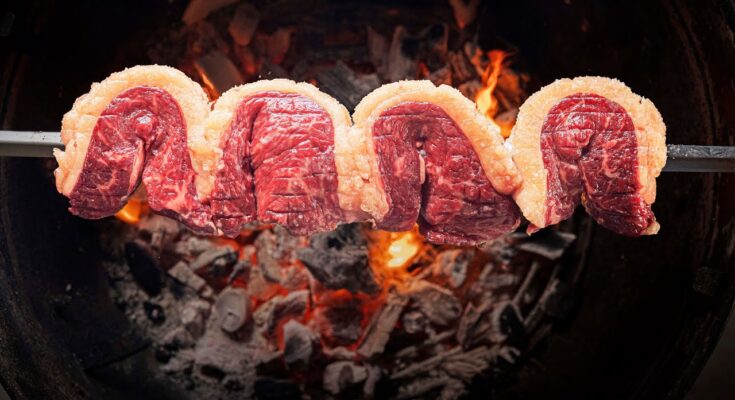Picanha Recipe: If you’re a meat lover, especially fond of rich, juicy, and flavorful steaks, you’re in for a treat with Picanha. Pronounced “pee-KAHN-yah,” this beloved Brazilian beef cut is one of the most underrated yet mouthwatering pieces of meat you’ll find. It’s essentially the top sirloin cap, also known in some regions as rump cap or coulotte. What sets it apart from other beef cuts is the thick fat cap on top, which melts during cooking and bastes the meat, giving it an irresistible flavor and buttery texture.
Picanha is not a cut you typically find highlighted in American steakhouses or standard grocery stores. In fact, it’s often divided into smaller cuts in many Western butchering styles. But in Brazil, it reigns supreme—often being the star of the show at a churrascaria, or Brazilian steakhouse. Once you try it, you’ll understand why people rave about its succulent taste and juicy tenderness.
Origin and Popularity in Brazilian Cuisine
The love for Picanha began in South America, particularly in Brazil. In Brazilian culture, grilling meat is more than just cooking—it’s a tradition, a celebration. And at the center of most Brazilian barbecues is the picanha, proudly skewered, seasoned with just rock salt, and cooked to smoky perfection over hot coals.
Picanha’s popularity grew not just because of its flavor, but also because of its cooking simplicity. It doesn’t require a long marinade or complex techniques. With the right preparation, even a home cook can turn this cut into something restaurant-worthy. Thanks to social media and food influencers, Picanha has gained international attention. Today, it’s loved by foodies around the world for its bold taste and show-stopping presentation.
Why You Should Try Cooking Picanha
Unique Flavor Profile
Picanha has a distinct beefy taste that sets it apart from other steak cuts. What really elevates it is the fat cap. Unlike marbled cuts like ribeye, picanha’s fat is concentrated in one thick layer. This allows the fat to render slowly, infusing the meat with flavor as it cooks. The result is a steak that’s not just juicy but packed with a smoky, buttery richness that’s hard to match.
Another thing that makes Picanha special is its texture. When cooked correctly—usually to medium rare or medium—it retains a soft chew without becoming mushy or overly tough. The outer crust, when seared properly, adds a lovely crunch that contrasts beautifully with the tender interior. It’s no wonder this cut has a loyal fan base.
Cost-Effective and Impressive Dish
One of the best parts about cooking Picanha at home is that it’s a budget-friendly showstopper. While cuts like ribeye or filet mignon can be expensive, picanha is often more affordable yet equally impressive in both presentation and flavor. This makes it an ideal choice for dinner parties, family barbecues, or just a weekend treat.
Additionally, cooking picanha doesn’t require fancy ingredients or tools. You don’t need a high-end grill or sous-vide machine. A cast-iron skillet, some coarse salt, and a bit of know-how can go a long way. That means whether you’re an experienced home cook or a beginner, you can pull off a mouthwatering picanha meal with ease.
Selecting the Perfect Picanha Cut
How to Identify the Right Cut
To make the best Picanha, you need to start with the right cut of meat. When you’re shopping, ask your butcher specifically for “picanha” or “top sirloin cap.” If they’re unfamiliar with the term, you can mention that you’re looking for a cut from the rump area, typically triangular in shape with a thick fat cap on one side.
Look for a piece that is:
- Triangular in shape
- Weighs between 2 to 3 pounds
- Has a firm, creamy-white fat cap about ½ inch thick
- Bright red meat, indicating freshness
Avoid any cuts where the fat has been trimmed too closely, or where the meat looks dull and gray. Remember, the fat cap is essential for flavor, so make sure it’s intact.
Understanding the Fat Cap
The fat cap is more than just a visual feature—it’s the secret to Picanha’s rich flavor. As the meat cooks, the fat renders and bastes the beef, keeping it moist and juicy. Some people are tempted to trim it off to “reduce fat,” but that’s a mistake if you’re aiming for authenticity and flavor.
When grilling or roasting, the fat side should face upward or toward the heat source, so the rendered fat flows down into the meat. During the resting period, it continues to soak into the fibers, making each bite more tender and flavorful.
Essential Ingredients and Tools
Ingredients You’ll Need
One of the best things about Picanha is how simple the ingredients list is. You don’t need a long list of spices or a marinade. The goal is to let the meat shine on its own.
Here’s what you’ll need:
- 1 whole Picanha cut (2-3 pounds)
- Kosher salt or coarse sea salt (Rock salt is traditional)
- Black pepper (optional, but adds a nice kick)
- Olive oil (optional for searing in skillet)
That’s it. No garlic, no marinades, no fuss. Just salt, beef, and fire.
Recommended Cooking Tools
Depending on how you choose to cook your Picanha (grill, oven, or skillet), you’ll need some basic tools:
- Sharp chef’s knife (for trimming and slicing)
- Cutting board
- Meat thermometer (to avoid overcooking)
- Cast-iron skillet (for stovetop cooking)
- Charcoal or gas grill (for an authentic BBQ flavor)
- Tongs (for flipping meat safely)
While not necessary, having a skewer can make for a fun and traditional Brazilian presentation if you’re grilling. Some even opt to cook the picanha in a rotisserie, which is very effective in getting that juicy, even cook.
Step-by-Step Picanha Recipe
Step 1: Preparing the Picanha
The first step to mastering Picanha is proper preparation. Once you’ve got your hands on a high-quality cut, it’s time to get it ready for cooking. Start by rinsing the meat under cold water and patting it dry thoroughly using paper towels. Removing moisture helps you get that perfect sear later.
Next, you’ll want to inspect the fat cap. It should be about ¼ to ½ inch thick. If it’s much thicker, feel free to trim it slightly, but never remove it completely. That fat layer is where the magic happens—it bastes the meat as it cooks, keeping it juicy and full of flavor.
Place the meat fat-side down and use a sharp knife to remove any silver skin or tough membranes from the underside. Then, slice the Picanha into steaks—cut against the grain, about 1.5 to 2 inches thick. If you’re grilling Brazilian-style, you can fold each slice in a C-shape and skewer them like a crescent moon. If you’re cooking in a skillet or oven, keeping the cut whole or in thick steaks is perfectly fine.
Once sliced or portioned, let the meat sit at room temperature for about 30–40 minutes before cooking. This helps ensure even cooking and a better crust. Skipping this step might result in cold centers or uneven doneness.
Lastly, pat the steaks dry again before seasoning. Moisture is the enemy of that perfect Maillard reaction—the golden-brown crust that gives steaks their mouthwatering aroma and flavor. Now you’re ready for seasoning!
Step 2: Seasoning for Maximum Flavor
The beauty of Picanha lies in its simplicity, and the seasoning reflects that. You don’t need a marinade, rub, or a list of spices. All you really need is salt. Traditionally, coarse sea salt or rock salt is used—this draws out moisture, helps form a crust, and intensifies the meat’s natural flavors.
To season:
- Sprinkle a generous amount of coarse salt on all sides of the meat, including the fat cap.
- If you want a touch more complexity, you can add cracked black pepper. Some even rub on a light coat of olive oil before salting, especially when pan-searing.
- Avoid acidic marinades or sugary rubs—they can overpower the flavor or burn during high-heat cooking.
After salting, let the steaks sit for 15 minutes to allow the salt to penetrate. You’ll notice some moisture rise to the surface—that’s normal. It means the salt is drawing flavor from within.
One technique often used in churrasco-style grilling is salting just before grilling and brushing off the salt afterward. This gives the meat a salty outer layer without being overpowering.
For an optional flavor twist, consider rubbing the meat with garlic powder or smoked paprika, but only if you’re not aiming for a traditional Brazilian experience. Either way, don’t go overboard. Let the meat speak for itself.
Step 3: Cooking Methods (Grilling, Oven, or Skillet)
There’s more than one way to cook Picanha, and each method offers a unique flavor and texture. Here’s how to do it right whether you’re using a grill, oven, or stovetop.
Grilling (Traditional Churrasco Style):
- Preheat your grill to high heat (450–500°F).
- If using charcoal, let the coals burn until they’re white-hot for an authentic smoky flavor.
- Place skewered Picanha steaks fat-side up to allow juices to run down while cooking.
- Cook for about 4–5 minutes per side for medium-rare, depending on thickness.
- Move to indirect heat and cook for a few extra minutes if needed.
Pan-Seared (Stovetop):
- Heat a cast-iron skillet over high heat until smoking hot.
- Add a little olive oil and sear the Picanha steaks fat side down first to render fat.
- Sear each side for about 3–4 minutes, then lower heat and cook until desired doneness.
- Use a meat thermometer: 130°F for medium-rare, 140°F for medium.
Oven-Roasted (Whole Cut):
- Preheat oven to 375°F (190°C).
- Score the fat cap in a crosshatch pattern and sear in a hot skillet for 2–3 minutes.
- Transfer to the oven and roast for 30–45 minutes, depending on thickness.
- Use a thermometer to check internal temperature and avoid overcooking.
Each method has its perks. Grilling gives you that smokiness and crispy fat. Pan-searing is quick and convenient, while roasting is great for cooking a whole piece without slicing.
Step 4: Resting and Slicing the Meat
Once the meat is cooked to perfection, don’t rush into cutting it. Resting is critical—it allows the juices to redistribute inside the meat, so they don’t all pour out when you slice it.
Place the cooked picanha on a cutting board and tent loosely with foil. Let it rest for at least 10–15 minutes. Use this time to finish prepping your side dishes or set the table.
Now, onto slicing. Remember that meat fibers run in a specific direction called the grain. You should always cut against the grain, which shortens the muscle fibers and makes each bite more tender. Cutting with the grain results in a chewier texture.
Here’s how:
- Identify the direction of the grain.
- Use a sharp carving knife to slice the meat into thin strips.
- Cut at a slight angle for a more elegant presentation.
If you’ve cooked individual steaks, slicing isn’t as crucial unless you’re serving family-style. But for whole-roasted picanha, proper slicing makes a world of difference.
Step 5: Serving Suggestions and Sides
Picanha is delicious enough to be the star of the show, but the right sides can elevate your meal to unforgettable. In Brazil, it’s often served with rice, black beans, farofa (toasted cassava flour), and vinaigrette salsa. You can also serve it with fresh greens or grilled vegetables.
Here are some pairing ideas:
Traditional Brazilian Sides:
- Farofa: A nutty, crunchy cassava side that complements the juicy beef.
- Vinagrete (Brazilian salsa): Made with tomatoes, onions, parsley, and vinegar.
- Feijão Tropeiro: A flavorful bean and bacon dish popular in Brazilian barbecues.
Modern Western Twists:
- Garlic mashed potatoes
- Grilled asparagus or zucchini
- Roasted baby carrots with honey glaze
Sauces (Optional):
- Chimichurri – An herby, garlicky sauce that cuts through the richness.
- Aioli or horseradish cream – Great for a contrast in texture and flavor.
Don’t forget a glass of red wine or a cold Brazilian beer. A hearty Malbec or bold Cabernet Sauvignon complements the bold flavors beautifully.
Tips for Perfecting Your Picanha Every Time
Temperature is Everything
One of the key elements to mastering picanha is temperature control. Overcooking this prized cut can lead to dryness, and that’s a tragedy considering how flavorful and juicy it should be when cooked correctly. The ideal internal temperature for picanha depends on how you like your steak, but here’s a quick guide:
- Rare: 120°F (49°C)
- Medium Rare: 130°F (54°C) – most recommended
- Medium: 140°F (60°C)
- Well Done: 160°F (71°C) – not advised for picanha
Always use a digital meat thermometer inserted into the thickest part of the meat, away from bone or fat, to ensure an accurate reading. Cooking by feel alone can be risky, especially if you’re not very experienced.
If you’re roasting the picanha whole in the oven, remember to sear it first to lock in the juices. Then monitor it closely as it finishes in the oven. The difference between a juicy, buttery steak and a dry one is often just a few degrees.
The Rest Period is Non-Negotiable
We’ve touched on this before, but it bears repeating: resting your meat is crucial. After you take picanha off the heat, it’s still cooking internally. This is known as carryover cooking, and it typically raises the internal temperature by about 5°F.
Resting allows juices to reabsorb and redistribute. If you cut into it too soon, you’ll lose all that flavor onto your cutting board. A good 10 to 15 minutes under tented foil makes all the difference. Use that time to finish your sides, pour a drink, or just enjoy the smell of success in your kitchen.
Don’t Overcomplicate the Seasoning
Less is more when it comes to picanha. The richness of the meat combined with the crispy fat cap means it doesn’t need much help. While it’s tempting to experiment with rubs and sauces, try to appreciate the natural taste of the meat first. Once you’ve perfected the basics, then you can branch out with chimichurri, garlic butter, or other enhancements.
Common Mistakes to Avoid
Trimming Off the Fat Cap
One of the worst mistakes you can make with picanha is removing the fat cap entirely. It’s the essence of what makes this cut so flavorful and juicy. While you might trim it slightly if it’s too thick (over ½ inch), completely removing it is a big no-no.
The fat renders slowly during cooking and acts as a self-basting layer. It protects the meat from drying out and adds richness that’s hard to replicate with any sauce or seasoning. Keep it on, and let it work its magic.
Overcooking the Meat
Another common pitfall is overcooking. Because picanha doesn’t have heavy marbling like ribeye, it can dry out quickly if taken past medium doneness. If you’re unsure, always err on the side of undercooking, as you can always toss it back on the grill or pan for a quick finish.
Also, avoid cooking it too fast on high heat without allowing the fat to render. Fast sears are great, but then let it finish cooking more gently over indirect heat or in the oven.
Slicing the Meat Incorrectly
We can’t stress this enough: cut against the grain. It’s what separates a tender bite from a chewy one. Always examine your cooked picanha before slicing and identify the direction of the muscle fibers. Cutting across those fibers shortens them, giving you that buttery texture you’re aiming for.
Rushing this step or ignoring the grain can ruin all your hard work. Take the time to do it right.
Health Benefits and Nutritional Value
High in Protein, Iron, and B Vitamins
Picanha, like other beef cuts, is a protein powerhouse. A 3-ounce serving provides around 22 grams of protein, making it an excellent option for those trying to build muscle, support metabolism, or just stay fuller longer. It’s also a great source of iron, essential for oxygen transport in the body, and vitamin B12, which supports nerve health and red blood cell production.
Additionally, picanha offers zinc, niacin, and selenium, all of which play key roles in immune function and energy metabolism. Unlike processed meats, a properly cooked cut of picanha offers these benefits without unnecessary additives.
Balanced Fat Profile (When Consumed in Moderation)
While the fat cap is delicious, it’s important to note that it is, indeed, fat. This means picanha is higher in saturated fat than some leaner cuts. However, when eaten as part of a balanced diet and paired with healthy sides like vegetables or legumes, it can certainly fit into a healthy lifestyle.
Picanha can also be part of low-carb or keto diets due to its high fat and protein content with virtually zero carbs. Just be mindful of portion sizes and balance your plate with fiber-rich sides.
How to Store and Reheat Leftovers
Storing Leftover Picanha
If you’re lucky enough to have leftovers (rare, trust us), you’ll want to store them properly to preserve that juicy flavor. First, let the meat cool down to room temperature—don’t rush it into the fridge while hot.
Then:
- Place the slices or whole piece in an airtight container.
- Store in the refrigerator for up to 3–4 days.
- For longer storage, wrap tightly in foil and place in a freezer-safe bag to freeze for up to 3 months.
When freezing, try to separate slices with parchment paper to prevent them from sticking together. This makes it easier to thaw individual portions later.
Reheating Without Drying Out
Reheating picanha can be tricky—you don’t want to lose all that tenderness. Here’s the best method:
- Allow frozen meat to thaw in the fridge overnight.
- Preheat your oven to 250°F (120°C).
- Place slices in a baking dish and cover with foil.
- Add a splash of beef broth or olive oil to help retain moisture.
- Heat for about 10–15 minutes, or until warmed through.
Avoid microwaving unless it’s absolutely necessary—it tends to dry out the meat and make it rubbery. If you must use it, cover the steak with a damp paper towel and use low heat in short intervals.
Why Picanha Deserves a Spot in Your Recipe Repertoire
It’s the Best Steak You’re Not Cooking Yet
In a world full of ribeyes, filets, and sirloins, picanha is still a hidden gem for many home cooks. But once you try it, you’ll wonder why it took so long. It offers the perfect balance of flavor, texture, and simplicity—everything you want in a steak dinner.
It’s also versatile. Whether you’re throwing a backyard barbecue, impressing dinner guests, or just craving a weeknight steak, picanha fits the bill. And you don’t need fancy ingredients or equipment to make it shine.
It’s one of those meals that makes people go, “Whoa, what is this cut?!”—and that’s always fun.
FAQs about Picanha Recipe
1. What is Picanha?
Picanha is a popular Brazilian beef cut, known for its rich flavor and tenderness. It comes from the top of the rump and is easily recognizable by its thick fat cap, which adds juiciness when grilled or roasted.
2. How should I cook Picanha?
The most traditional method is grilling it over open flame or on a BBQ skewer, but it can also be pan-seared, oven-roasted, or cooked sous vide. The key is to cook it fat-side down first to render the fat and enhance the flavor.
3. Do I need to marinate Picanha?
No marinade is necessary for authentic Brazilian-style Picanha. A generous sprinkle of coarse salt is all you need. However, you can season it with garlic, black pepper, or herbs for added flavor if desired.
4. Should I remove the fat cap?
Keep the fat cap on! It bastes the meat as it cooks, locking in moisture and flavor. Trim it slightly if it’s too thick, but don’t remove it entirely.
5. What’s the best way to slice Picanha?
Always slice against the grain to maintain tenderness. If you’ve cooked it whole, let it rest for 5–10 minutes before cutting to retain the juices.
6. What internal temperature should Picanha be cooked to?
For medium-rare, aim for an internal temperature of 130–135°F (54–57°C). Use a meat thermometer to ensure accuracy.
7. Can I cook Picanha in the oven?
Yes, sear the meat in a hot pan first, then transfer it to a preheated oven (around 375°F/190°C) and roast until it reaches your desired doneness.
8. Where can I buy Picanha?
Look for it at Latin or Brazilian butcher shops. In some countries, it’s labeled as “rump cap” or “sirloin cap.” Ask your butcher if you’re unsure.
9. What sides go well with Picanha?
Traditional sides include farofa (toasted cassava flour), rice, black beans, chimichurri sauce, roasted vegetables, or a simple green salad.
10. Can I freeze cooked Picanha?
Yes. Allow it to cool, slice it, and store in airtight containers or freezer bags. Reheat gently to avoid drying it out.
Conclusion
If you’ve made it this far, congratulations—you’re ready to take on one of the tastiest and most rewarding beef cuts out there. Picanha is more than just a steak; it’s an experience. From its rich Brazilian roots to its juicy flavor and crisp fat cap, it delivers on every level. Plus, it’s easier to prepare than you might think.
Just remember:
- Choose the right cut.
- Keep the fat cap.
- Use simple seasoning.
- Cook with precision.
- Rest before slicing.
Master these, and you’ll have people lining up at your grill or dinner table. Whether you’re new to steak or a seasoned cook looking for something different, picanha deserves a permanent spot in your culinary toolkit.



